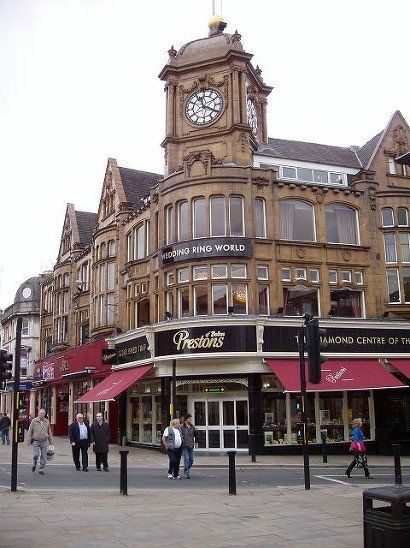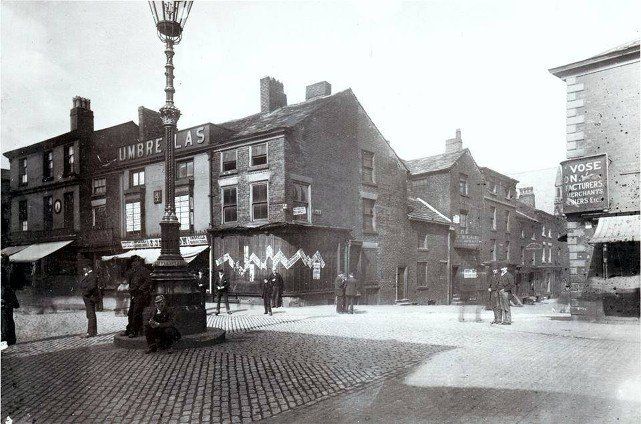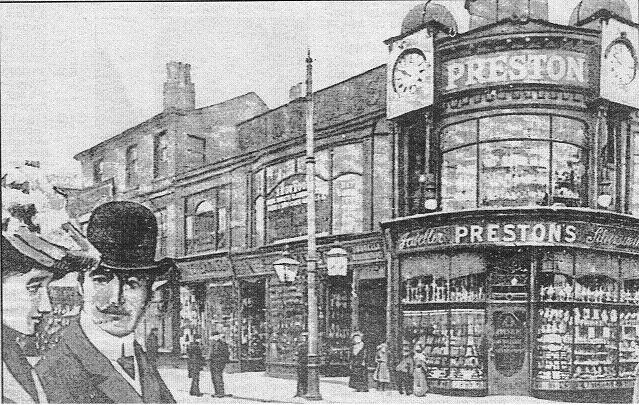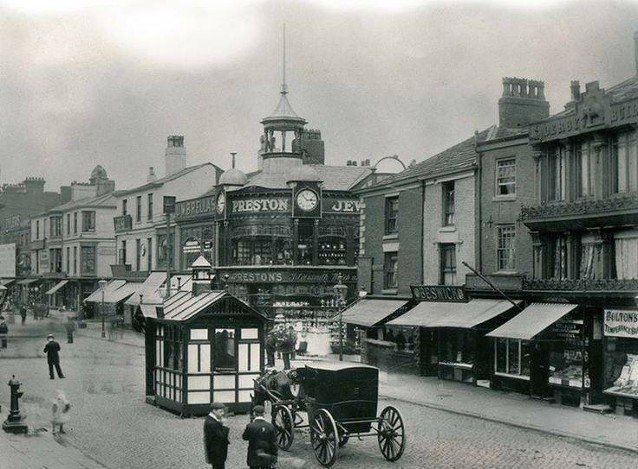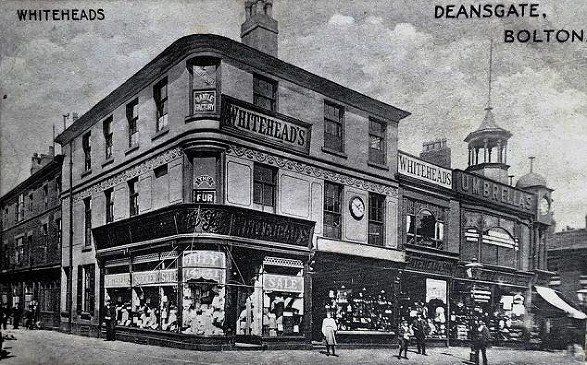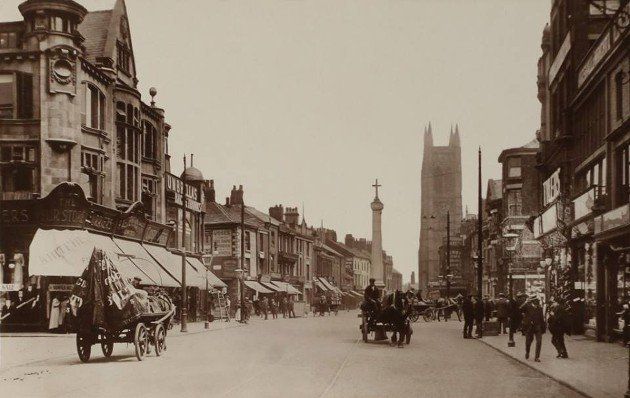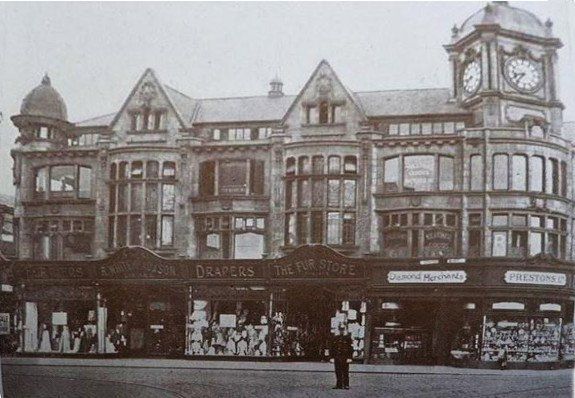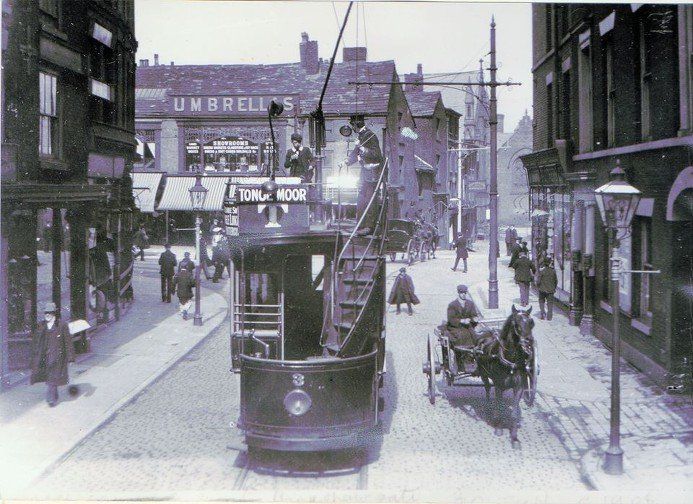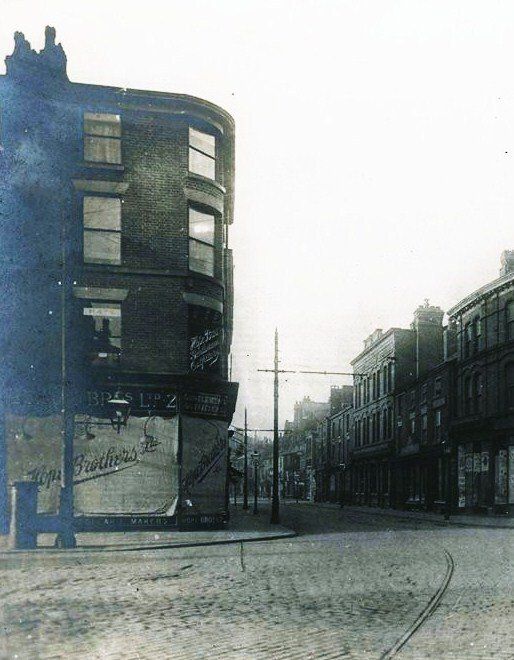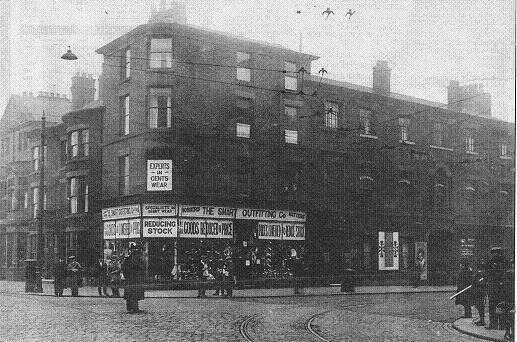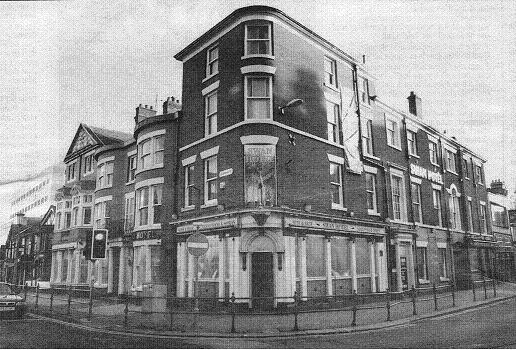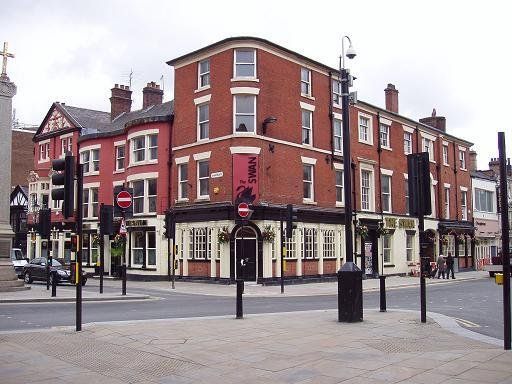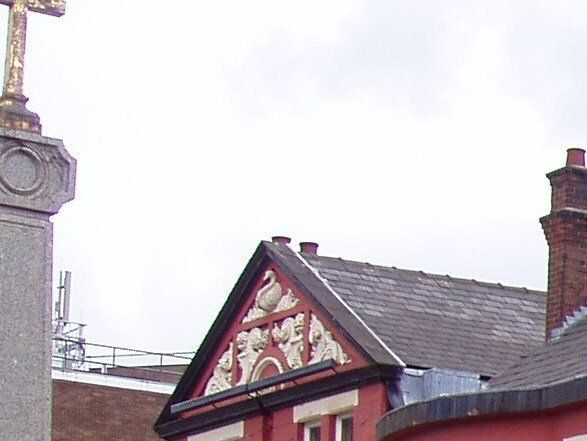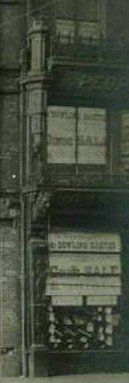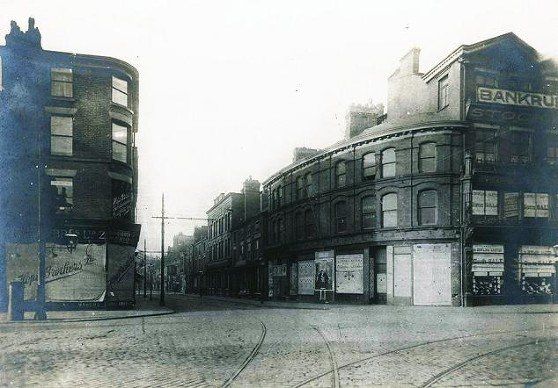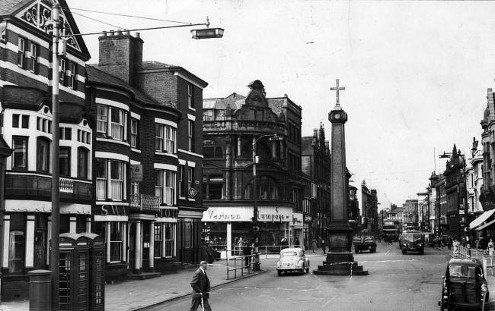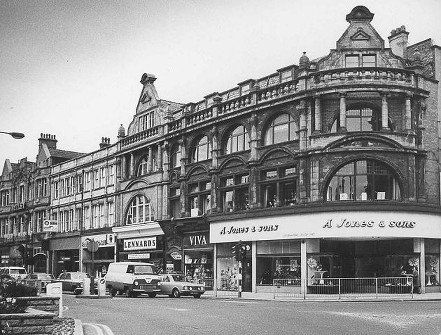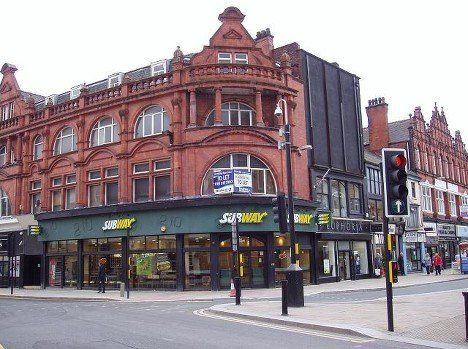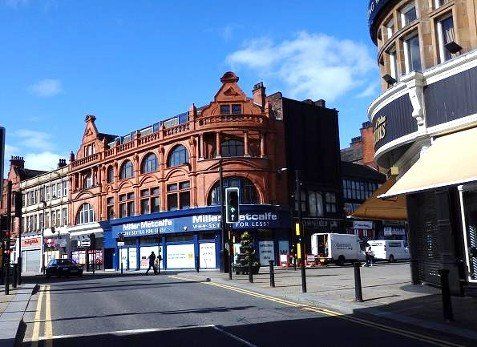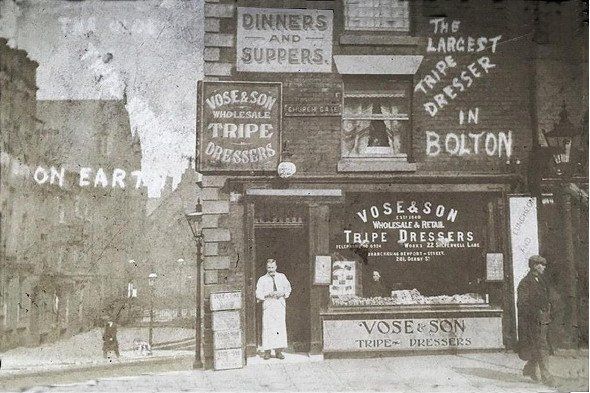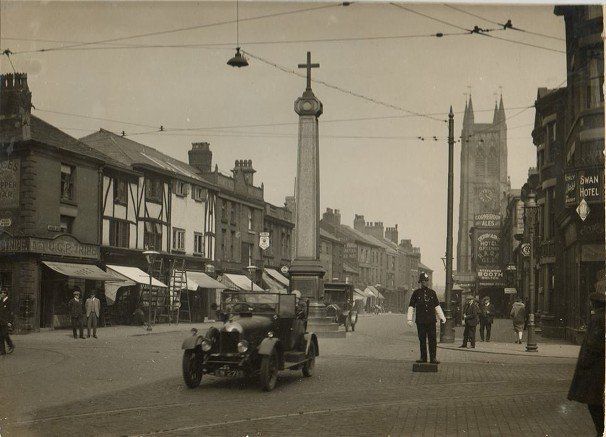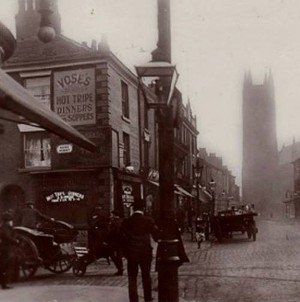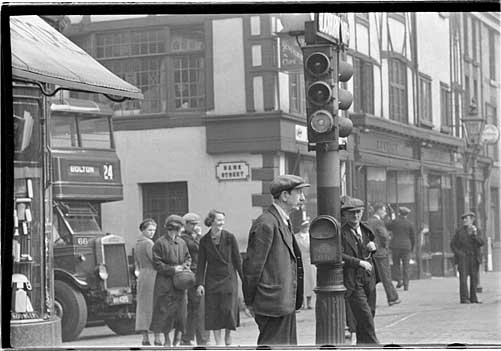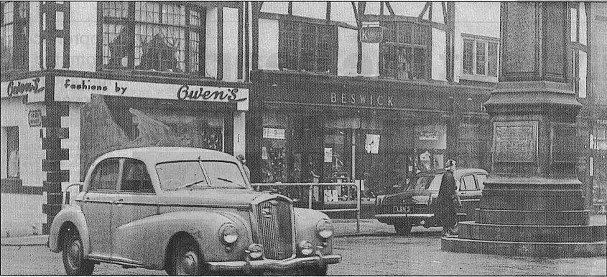Here is Preston's latest format pictured in September 2009.
Prestons was established on Bradshawgate in 1869 by James Preston a master Goldsmith and diamond merchant, In 1905 James Preston died of apoplexy, and the business passed to his niece, Gertrude Duckworth. It remained in the Duckworth family for four generations, and Gordon Duckworth joined the company in 1949 and began a phase of expansion opening a successful branch in Leigh as well as others. It was after Gordon's son Andrew joined the firm in 1972 that a new marketing tactic saw Prestons become probably the first jewellery retailer in the country to and started advertise on television. Preston's was marketed as a true destination store with a conceptual and ground-breaking national marketing campaign using television and the cinema.
In 1905 Preston’s acquired the site on the West corner of Deansgate / Bank Street. In 1909 Whiteheads acquired the rest of the block as far as Crown Street and remodeled it to its present form. In 1913 Prestons rebuilt to match Whiteheads.
The business name was changed to Preston & Duckworth in 2002. The company struggled in the face of the high street spending slowdown and the family-owned firm, with seven shops around the country, was placed in administration in June 2005 after running up debts of more than £3million. Administrators were forced to sell Preston & Duckworth stores individually because potential buyers were reluctant to risk buying the whole business.
Prestons of Bolton is now owned by Macclesfield based Cotrills.(2015)
In 2016 Prestons had a long-running closing down sale and finally closed
Corner of Bank Street and Deansgate with Churchgate to the right and Bradshawgate behind the camera. Date unknown. Clearly after 1877 because the Umbrella Shop is there.
The UMBRELLA shop of James Jameson was a prominent landmark. He is known to have been at 6 Bradshawgate in 1871 and moved here to 4 Deansgate in 1877. Immediately to its left is a small shop which is Whiteheads. It is not clear on this picture whether they also occupy the larger building further to the left but not much later they would occupy most of the block.
The "new" Unitarian Chapel can just be seen to the left of the Vose sign. Notice on that corner the stone quoins which remain visible for many years but the rest of the wall is plain without any half timbering.
We notice J Bell's shop on Bank Street.
There are a number of ghosts on the picture caused by people not remaining still over the longish exposure needed by the cameras of that era.
This is the next appearance of that corner. Prestons moved here in 1905 but is unclear when this building was erected. Notice that Jamesons and Whiteheads have had their frontages improved.
A bit of cut and paste is suspected at the lower left hand corner!
The picture could well be an advert for Preston's
This is the same building but we can see it more clearly with its tower.
The Umbrella shop is still next door so the picture dates between 1905 (when Preston's moved in) and 1909 (When Whitehead's acquire the whole block to the left of Preston's).
Churchgate. There is no real or false half-timbered frontage. At the right of the picture we have a rather fine building with ornate balconies which in 1890 had a sign board above the gutters proclaiming “ Taylor, Builder” but now indicates “Derby Building” (or builders). The centre of the sign board depicts the elephant and castle (c1890 and c1908) which has been for many years a symbol of Bolton. Gaskell Court is at the bottom right of this building.
We note Beswick's which was still there in the 1960s. Also Bolton's Temperance Bar.
We have the cabbies' cabin. There was a similar one at the taxi rank on Trinity Street.
c1905
A picture from David Whenlock's collection
This is from the Crown Street end of the block and is probably contemporary with the picture above. It shows clearly that at this time Whiteheads own the block from Crown Street to the Umbrella shop but have not yet rebuilt it into the form with which we are familiar.
For all its simplicity it is already quite atttractive in its details with the leaf frieze, the shop corner typical of the better shops of that era and the plain rectangles one of which has the clock.
Picture posted on Facebook by Peter Lodge.
Whiteheads has now been rebuilt and the Market Cross is in place so the picture is no earlier than 1909 but the latest Prestons building has not yet appeared so is before 1913. We notice that the Umbrella shop is still there.
The whole Whiteheads and Prestons building shortly after 1913. When Whitehead's was first rebuilt it was symmetrical about a single gable. When Prestons rebuilt a second gable was created, occupied by Whitehead's Fur Store but Prestons occupied the other symmetrical part of the frontage as well as the corner.
Another policeman with not a lot to do. It's a bobby's job!
A fantastic picture from Edward Thompson.
The date is no earlier than 1900 when the trams were electrified.
The Umbrella shop has had its frontage modernised so it is like the second of the pictures above, not the first.
The shop on the corner (later Preston's) predates both Preston's buildings.
This means that the building that Preston's moved into in 1905 was built no later than 1900 and was replaced in 1913 giving it an even shorter life than we had assumed.
We note the older and newer Unitarian Chapels on Bank Street and the Swan Inn on the right with Hope Bros shop still occupying the corner.
There appear to be lights on the tram which were not part of the normal tram equipment but the sun is casting strong shadows including a shadow of the lamp on the letter T. I wonder what is going on. The picture appears to be staged.
Opposite Prestons was the Swan Hotel and Hope Bros gentlemen's outfitters.
The Bradshawgate Churchgate corner, apparently at one time was known as "Hope" or “Hope's Corner”. This is before the widening of Bradshawgate c1910.
Hope Bros Gentlemen's outfitters no. 2 Churchgate.
This premises on the corner separates the two part of the Swan Hotel on Churchgate and Bradshawgate.
It may be that at this date it is no longer Hope Bros. It has been renamed "The Smart Outfitting Co, hosiers, hatters", "Experts in Gents wear". we see that "all our goods are reduced in price" "prices lowered to reduce stock" and "reducing stock".
It may be that this is because the Swan Hotel has bought the property and is about to amalgamate it into the hotel.
The two separate parts of the Swan can be seen either side of the shop.
Swan Hotel corner, the shop has now disappeared.
It is believed that a Swan Hotel has stood on this site since the 1700s or earlier. The present building dates from about 1845. It was extended and altered in 1930-31 and 1984-5.
Note at this date the no entry to Churchgate and the modern building at far left.
24th September 2009 (C)WDC
No change really from the previous picture.
The part of the building to the right of the archway is still part of the Swan but has been named Barristers. Next door to the right is The Appletree.
Look at the gable at the left hand end.
See the Swan at the top.
Probably 1897
The Swan, Churchgate, is decorated probably for Queen Victoria's Diamond Jubilee.
Notice the cabbie’s hut.
With the ladder and the way the men are posing, the middle two appear to have overalls on,
On the right, across Bradshawgate just behind the rounded corner building of is the ancient fustian warehouse part of which still exists.
VR Victoria certainly. There is probably a date on the scroll below the crown but it cannot be read. 1897 is much more likely than the Golden Jubilee ten years earlier.
Corner of Bradshawgate (into the picture) and Deansgate (to the right). This is the full picture of which the left hand side was shown above.
Bankrupt sale. But all the shops in the block to the left have ceased trading. Are they all closing down in preparation for demolition c1910?
At the right of the picture (Bankrupt) are the fustian warehouses, partly demolished when this corner was redeveloped and partly remaining today.
Detail of woodwork and the iron rails on the window ledges.
Bolton Evening News picture, 1957
Bradshawgate Deansgate corner.
Viewed from Churchgate with a name on the corner shop that some may remember - Vernon Humpage. Shoe shop?
The high square box of a building just beyond Vernon Humpage is the remaining part of the fustian warehouse.
Bolton Museum Archive picture
1997.Bradshawgate Deansgate corner.
You can see back as far as the Fleece, here called the Gaiety, before that Maxim's, lately the Flying Flute and now (2021) empty. ("Fleece Hotel" can still be seen in the terra-cotta brickwork above the door.) The large shop on the corner will be remembered by many as Jones shoe shop.
24th September 2009 (C) WDC
Subway occupy this corner. They extend into what was VIVA on the picture above.
This is a really nice building. They got it right in 1910 or thereabouts.
Part or all of this building is called the Whewell Building.
Euphoria and the black cladding above it are the ancient fustian warehouse.
December 2016 (C)WDC
By 2016 Subway had closed and the shop had been empty for a while. It is now being renovated for Miller Metcalfe whose frontage makes Subway look quite elegant and restrained!
The fourth corner is the corner of Bank Street and Churchgate where for many years stood Vose's tripe dressers shop. Scratched into the negative of the original photograph at the left are the words THE OLDEST TRIPE SHOP ON EARTH.I am guessing that the words at right "The largest tripe dresser in Bolton" are also on the negative, not painted on the wall.
One of David Whenlock's postcards posted December 1903. (enhanced by WDC)
The signs are different from those to be seen on the picture near the top of this page.
Vose, established 1840 had a number of shops in Bolton. The writing on the window specifies just two others at this time - 46 Newport Street (Wheatsheaf Hotel) and 281 Derby Street (corner of High St) together with works at 22 Silverwell Lane.
UCP was formed in 1920 with the amalgamation of Vose of Bolton, Mason of Burnley and Cox of Bury. Part of the agreement was that the Vose name would continue to appear as well as UCP. (Denis McCann)
Some time later there were many UCP shops in Bolton - most also retaining the name Vose. Ones which will be familiar to people looking at pictures of Old Bolton will be the one next to the Wheatsheaf on the Great Moor Street / Newport Street corner, The restaurant on Deansgate close to Oxford Street and the one on Bradshawgate near the Lido cinema.
Notice that the wall is clearly brick built with no sign of half-timbering. Note that Churchgate appears to be Church Gate.
Picture from Edward Thompson.
Probably 1920s
The corner shop is now clearly UCP though Vose still appears on the awning and on the sign on Bank Street.
The wall is still brick or maybe rendered but there is now mock Tudor black and white on two shops to the right and at Gaskell Court.
"Steelwork, Booth, Bolton" - is on the iron and glass awning at the front of the Theatre Royal. Is the awning just being constructed?
The policeman has a little box to stand on.
Quite early picture of this corner. No information available.
At this date the Golden Lion has a full width sign at roof height.
Bolton Museum Archive Humphrey Spender collection 1937.
The corner shop is no longer UCP or Vose's and now has fake half-timbering
Bolton Evening News April 1957.
Owen's, Beswick with K shoes.
Wolseley car with a back end like a Morris; a lot of police cars were the high powered version of this model.
On the next couple of pages we look around Churchgate, Church Bank and Church Wharf.

